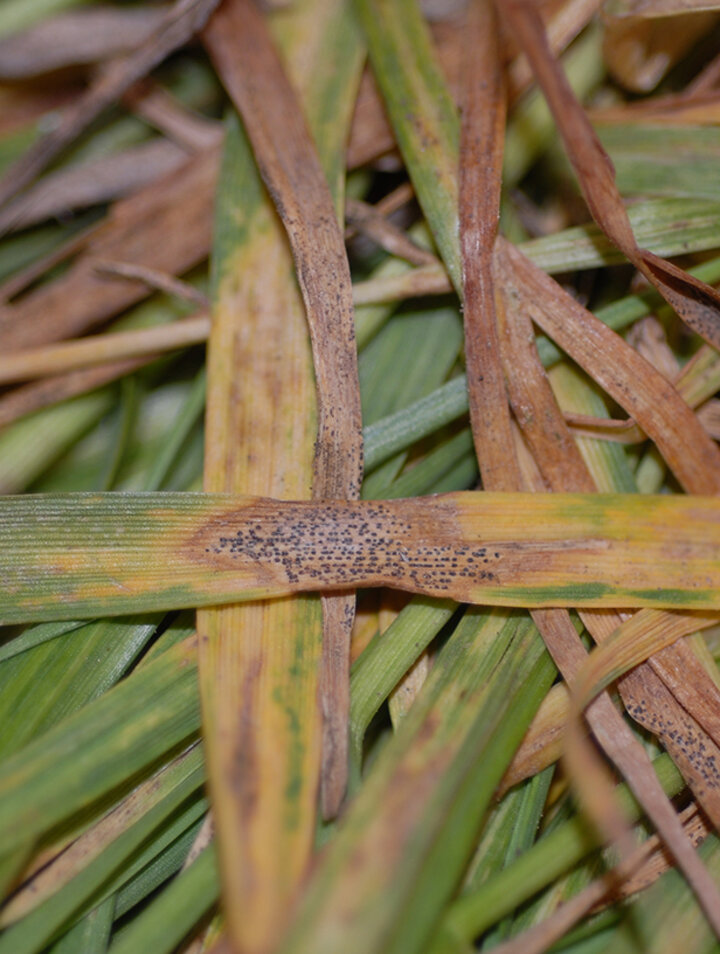The prolonged cold or cooler-than-normal temperatures this spring have delayed the onset of wheat diseases in Nebraska. With the return of seasonal temperatures, it is expected that wheat diseases will start to develop and progress, making this a good time to start scouting. As is typical early in the growing season, many wheat fields will look disease-free from a distance (Figure 1); however, closer examination of the upper and lower canopy can reveal diseases.
What to Look for When Scouting
Stripe Rust. Stripe rust was confirmed in one county in southeastern Kansas during the week of April 9, indicating there is a good chance we will have the disease in Nebraska. Because it is favored by cool temperatures and moisture, it is one of the diseases to look for when scouting early in the growing season. Look for yellow rust pustules (Figure 2) both in the lower and upper canopy. On young wheat, stripe rust may not form distinct stripes on the leaves.



Fungal Leaf Spot Diseases. The most common early season fungal leaf spot diseases in Nebraska wheat are tan spot and Septoria leaf blotch. During the early stages of development, symptoms of these two diseases are not distinguishable. They consist of spots with brown necrotic centers surrounded by yellow halos (Figure 3). These spots start on the lower leaves and progress up the plant. They can enlarge into large dead areas on leaves. In older lesions of Septoria leaf blotch, tiny, black fruiting structures known as pycnidia may develop (Figure 4). Tan spot and Septoria leaf blotch are most severe in fields with wheat residue on the soil surface.
Powdery Mildew. Powdery mildew starts on the lower leaves and stems where humidity remains high for prolonged periods of time. It is characterized by white, cottony patches of mycelium and conidia (asexual spores) on the plant surface. The white patches later turn dull gray-brown. Look in the lower canopy for powdery mildew (Figure 5).



Virus Diseases. Virus diseases of wheat commonly seen early in the growing season in Nebraska are soilborne mosaic (Figure 6) and wheat streak mosaic (Figure 7). Typical symptoms are stunting and mild green to conspicuous yellow leaf mosaics that give the field a yellow cast. Wheat soilborne mosaic is favored by wet soils and is more common in eastern Nebraska. Wheat streak mosaic occurs more frequently in areas of western Nebraska where volunteer wheat was not controlled prior to planting wheat in the fall.
Management
The Economics
Due to low wheat prices, apply a fungicide only if you have to. Multiple applications in one growing season may not be profitable or economically feasible.
Early season fungal leaf diseases can be controlled by applying a fungicide (see 2018 NCERA-184 Wheat Fungicide Table). Do not apply a fungicide in the absence of disease. Base the decision to apply a fungicide early in the growing season on the following:
Presence of Stripe Rust Based On Scouting. If stripe rust is detected early in the growing season and cool, wet weather is forecast, an early fungicide spray may be warranted. Even if you have planted a variety known to be resistant to stripe rust, if the disease is detected in the field under cool, wet conditions, a preventive fungicide application will be worthwhile. On the other hand, if dry, warm weather is forecast, it will be better to wait but continue monitoring the progression of stripe rust in the field.
Fungal Leaf Spot Diseases and Powdery Mildew Developing to Severe Levels. If wheat was drilled into wheat stubble and tan spot, Septoria leaf blotch, or powdery mildew are developing to severe levels, an early season fungicide application may be warranted. Under normal weather conditions, these diseases develop slowly enough that a flag leaf fungicide application alone is sufficient to control them effectively.
Accurate Identification of the Disease Present in a Field. It is important to positively identify the disease present in a field before deciding whether to apply fungicide. Virus diseases such as soilborne mosaic and wheat streak mosaic cannot be controlled by applying a fungicide.
Virus diseases cannot be controlled once they occur. Wheat soilborne mosaic is managed by planting resistant varieties and ensuring good soil drainage. Wheat streak mosaic is managed by controlling volunteer wheat before wheat planting in the fall and choosing varieties with good tolerance or resistance.

